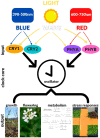Cryptochromes and the Circadian Clock: The Story of a Very Complex Relationship in a Spinning World
- PMID: 33946956
- PMCID: PMC8145066
- DOI: 10.3390/genes12050672
Cryptochromes and the Circadian Clock: The Story of a Very Complex Relationship in a Spinning World
Abstract
Cryptochromes are flavin-containing blue light photoreceptors, present in most kingdoms, including archaea, bacteria, plants, animals and fungi. They are structurally similar to photolyases, a class of flavoproteins involved in light-dependent repair of UV-damaged DNA. Cryptochromes were first discovered in Arabidopsis thaliana in which they control many light-regulated physiological processes like seed germination, de-etiolation, photoperiodic control of the flowering time, cotyledon opening and expansion, anthocyanin accumulation, chloroplast development and root growth. They also regulate the entrainment of plant circadian clock to the phase of light-dark daily cycles. Here, we review the molecular mechanisms by which plant cryptochromes control the synchronisation of the clock with the environmental light. Furthermore, we summarise the circadian clock-mediated changes in cell cycle regulation and chromatin organisation and, finally, we discuss a putative role for plant cryptochromes in the epigenetic regulation of genes.
Keywords: Arabidopsis; cell cycle; chromatin; circadian clock; cryptochromes; epigenetic; gene expression regulation; light.
Conflict of interest statement
The authors declare no conflict of interest. The funders had no role in the design of the study; in the collection, analyses, or interpretation of data; in the writing of the manuscript or in the decision to publish the results.
Figures


References
-
- Kami C., Lorrain S., Hornitschek P., Fankhauser C. Current Topics in Developmental Biology. Volume 91. Academic Press Inc.; Cambridge, MA, USA: 2010. Light-regulated plant growth and development; pp. 29–66. - PubMed
Publication types
MeSH terms
Substances
LinkOut - more resources
Full Text Sources
Other Literature Sources

